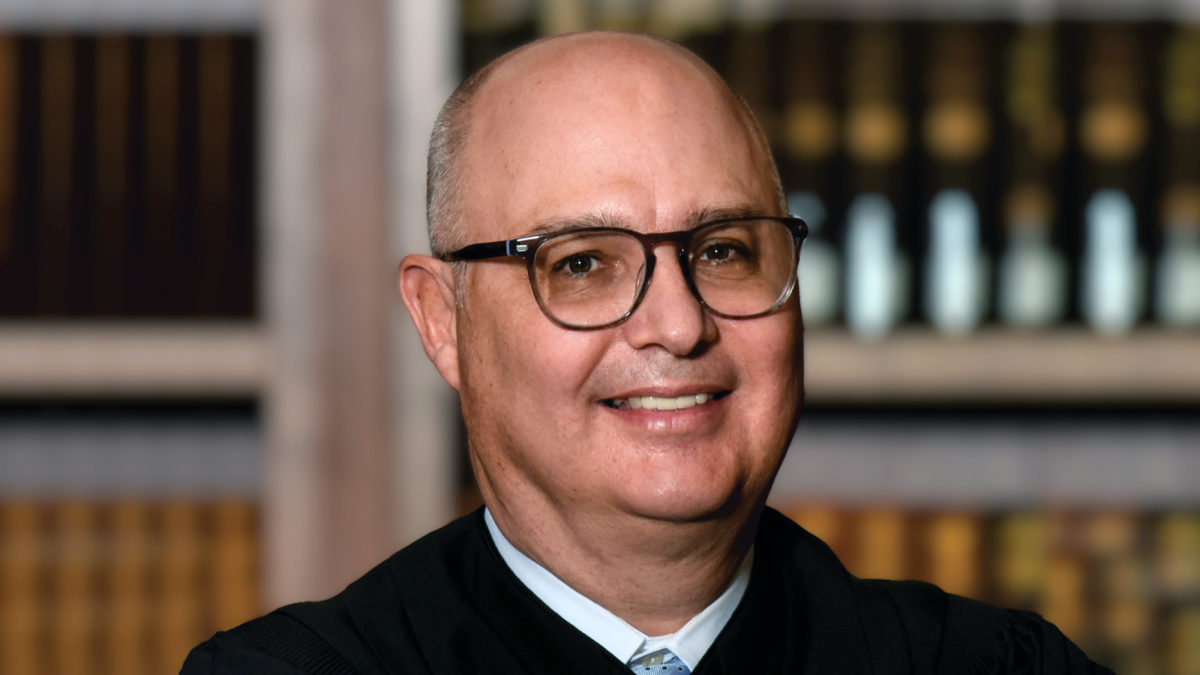
Updates from the Chief Justice
January/February 2023
Download This Article (.pdf)
In the not-too-distant past, former Chief Justice Nancy Rice authored a quarterly article for Colorado Lawyer called The Chief’s Corner.1 Chief Justice Rice created the column to provide updates on happenings within the Judicial Branch, the legal community, and the Supreme Court and, occasionally, as an outlet for humor.
I’ve resurrected this column in 2023 to provide updates on our workplace culture initiative, our internal operations, and our efforts to work with the bar to enhance our services and improve access to justice. It’s no secret that the past three years have presented some unprecedented challenges for the Judicial Department, and I welcome the opportunity to explain to the bar how we have responded.
Allegations in the Media
Beginning in early 2021, local media reported that the Judicial Department might have awarded a “hush money” contract to a former employee who threatened to expose alleged improper behavior within the Department. Although the contract in question had been canceled years before the media accounts proliferated, the news was disturbing and disheartening for the hundreds of judicial officers and thousands of departmental employees around the state who take great pride in working hard to serve their communities. This accusation hurt our collective reputation and undermined the outstanding work of Colorado’s Judicial Department.
When this media narrative emerged, the Supreme Court and the Judicial Department were constrained in what we could say publicly due to a variety of contractual and statutory obligations. Our inability to provide a comprehensive explanation fueled speculation and additional media attention. In my February 2021 State of the Judiciary address, I committed to a thorough, independent investigation of the allegations. I invited the state legislature and Governor Polis to form a panel that would independently select investigators to look into the allegations. That panel solicited and reviewed bids, interviewed applicants, and ultimately selected two investigators: Former US Attorney Bob Troyer’s team was hired to investigate the allegations of a quid pro quo contract; and Investigations Law Group (ILG), led by Liz Rita, was hired to investigate the allegations in the “memo” and conduct a comprehensive review of the Judicial Department’s workplace culture. With our full cooperation, these outside investigators conducted over a hundred interviews and reviewed tens of thousands of documents.
In June 2022, the investigators finalized their reports, which the Department made public without redactions.2 Although some of the findings were sobering and, at times, upsetting to read, the reports did not support much of the media narrative over the prior 18 months. The Troyer team concluded there was no “hush money” contract, and ILG determined that many of the allegations in the “memo” were unfounded or distorted. I strongly encourage everyone to read the reports rather than merely relying on the media’s characterization (or even my characterization) of the findings. Additionally, a few months before these reports were published, a separate investigation conducted by the Office of the State Auditor similarly did not support the local media coverage about a quid pro quo contract, but it did find potential wrongdoing by several former employees of the Department.3 Nevertheless, these investigations showed us important ways to improve our organization. Therefore, I want to provide a bit more detail about the Troyer and ILG reports and, most important, our implementation of their recommendations.
Implementation of Recommendations
The Troyer and ILG investigation reports revealed that, although the Judicial Department had made many changes since 2019 to enhance its core administrative and support work, the Department still had work to do. Both reports contained recommendations for improving the Department’s operations and workplace culture. We’re embracing all of them.
Troyer Report
The Troyer report contained recommendations for strengthening the Department’s personnel and fiscal rules, ensuring that Department leadership receives adequate support and training, and improving transparency in decision-making and communication. Consistent with these recommendations, the Department is revising rules, better defining leadership roles, improving training, and emphasizing more detailed ethical expectations.
ILG Report
The ILG report was separated into two sections. The first section examined what the media has called the “memo”—a list of undated allegations about prior human resources matters within the Department. The ILG report revealed that the list encompassed a handful of events taking place in an organization with thousands of employees over two decades. The author of the list implied that those problems were either ignored entirely or addressed inadequately. ILG determined that although every allegation had a grain of truth, the allegations lacked context or were exaggerated. In most cases, the Department’s Human Resources Division had addressed or investigated the allegations when they occurred. Nevertheless, ILG faulted the Department for its handling of some allegations and encouraged greater vigilance going forward. I agree.
ILG’s second section scrutinized the Department’s workplace culture.4 Overall, ILG found that the Judicial Department has a very positive workplace culture and, by and large, our employees are proud to work for us. As is the case with many large organizations, ILG also found areas for improvement. Women, who make up about 77% of our non-judge employees and about 44% of our judges, were somewhat less positive about our culture and felt less comfortable reporting workplace issues. Most disheartening to me was learning that some of our employees did not feel comfortable reporting bad behavior or workplace concerns for fear of retaliation. That is not acceptable, and we must do better.
With the input of the entire Court, I tasked Justice Monica Márquez and our state court administrator, Steven Vasconcellos, to implement the workplace culture recommendations from the Troyer team and ILG. This is not a short-term project, and with Justice Márquez tapped to be the next chief justice, it made sense for her to be at the forefront of these critical organizational reforms. These tasks involve reviewing and improving our current structure and processes as well as requesting resources from the General Assembly to modernize our human resources and staff support functions. Among other things, these reforms will clarify and streamline the reporting of misconduct within the Department; create additional resources for employees who have questions or need assistance navigating an issue they are facing; increase the Department’s diversity, equity, and inclusivity efforts; and provide regular training to our employees on how to handle issues that arise in the workplace.
Although these initiatives were prompted by the investigations, we are making these changes because we truly believe they will improve our workplaces statewide. The Judicial Department has grown dramatically over the past 20 years and, unfortunately, our human resources systems, employee support functions, and overall mission and vision as an organization have not kept pace. These changes are essential regardless of their genesis. I plan to provide the bar with additional updates about our efforts on these fronts.
Supreme Court Involvement in Departmental Administration
The investigations highlighted a structural problem that the Supreme Court has been attempting to address over the past three-and-a-half years. For a long time, the chief justice was the only member of the Court responsible for overseeing the Department’s administrative work. The chief relied heavily on the state court administrator to stay informed of Department issues and priorities. The Court’s associate justices would receive brief, high-level updates from the chief justice or state court administrator on an as-needed basis, but the other justices were by design walled off from issues that might come before the Court.
Starting in 2019, the Supreme Court collectively questioned the design of this system. We began working more like a board of directors that meets at least weekly. This new system helps the chief justice receive additional perspectives and eases some of the administrative burdens of the chief. The other justices are still walled off from legal issues that have a higher likelihood of coming before the Supreme Court, such as individual employment matters, individual complaints of judicial misconduct, and contractual disputes that might result in litigation. Instead, the Court’s involvement in administrative affairs is almost entirely at the policy development and implementation level, such as determining budget priorities, revising fiscal rules and personnel rules, managing IT priorities, and ensuring administrative support for probation offices statewide. We believe these changes have been positive, and the Court is now much more aware of the scope of the Department’s administrative work and can provide support in new and different ways. This approach has the benefit of broadening communication throughout the branch and better preparing the incoming chief justice for the administrative responsibilities accompanying that role.
With the entire Court’s increased involvement in managing our administrative affairs, and with our continued work assessing and improving workplace culture, it became apparent that we need to hear directly from judges and employees throughout the state. We have therefore embarked on a “listening tour.” Specifically, the seven justices have divided up the state and traveled to every judicial district in Colorado over the past few months, conducting multiple meetings with judges, court employees, and probation officers. Our collective mission was to have in-person conversations to understand what is going well, what we need to improve, and what might not be apparent in the normal course of our work. After the pandemic necessitated isolation and limited in-person interactions, we have found these listening sessions to be fulfilling and encouraging. We have received frank feedback on a range of issues, and we have heard many thoughtful and innovative ideas. We certainly have work to do, but it is all with the goal of making our workplace exemplary and ensuring that every employee has a voice and is proud of where they work.
Judicial Discipline Legislation
I also want to provide a brief update on legislation that impacts the disciplinary process for judges and justices.5 Last year, the General Assembly passed SB 22-201, which clarified the Department’s reporting and disclosure obligations and provided independent funding for the Commission on Judicial Discipline. SB 22-201 also created an Interim Legislative Committee on Judicial Discipline tasked with evaluating Colorado’s system of judicial discipline and recommending constitutional or statutory changes. The Interim Committee met five times between June and September. During those meetings, it became clear that Colorado is an outlier in some aspects of judicial discipline, and that constitutional and statutory changes are necessary to improve our system for the benefit of all. The Committee determined that our system of discipline can be improved through greater transparency, increased due process for judges subject to discipline, and additional support and resources for complainants. The Interim Committee ultimately approved two bills—one concurrent resolution for constitutional changes, and a separate package of statutory changes. The proposed changes are available on the Interim Committee’s web page.6 One additional bill related to the creation of a Judicial Discipline ombudsperson did not advance out of committee. We expect the legislature to take up that issue again this session, and we believe that an ombudsperson who operates outside of the Judicial Department is appropriate to provide resources and support related to the judicial discipline process.7
I want to thank the Colorado Bar Association, the Colorado Women’s Bar Association, the various diversity bar associations, the Institute for the Advancement of the American Legal System, the Colorado Judicial Institute, the National Center for State Courts, the Commission on Judicial Discipline, and everyone else who participated in the Interim Committee process. I also want to thank the legislators serving on the Interim Committee for establishing and maintaining a truly bipartisan process that avoided politicization of the Colorado Judiciary.
Moving Forward
I will provide further updates on these matters in my State of the Judiciary address in early 2023, and I’ll continue to provide meaningful updates in this column. In addition to the listening tour described above, the Supreme Court has a great interest in hearing from attorneys around the state. We have visited with many bar associations, and we plan to do more of this. I hope to see many of you in person in the coming months and years. Thank you all, and be well.
Notes
1. Chief Justice Rice’s column spanned her term as chief justice, running from January 2014 to June 2018.
2. https://www.courts.state.co.us/announcements/LeadershipServicesContract.cfm.
3. The Auditor’s Fraud Hotline Investigation Report can be found on the Judicial Department’s web page at https://www.courts.state.co.us/announcements/AuditUpdate.cfm.
4. Characterizing the Department’s workplace culture is particularly difficult. Although we have centralized administrative support, each judicial district has independent leadership and makes independent operational decisions. Even within our districts, there is not a monolithic culture; it can vary from courthouse to courthouse and even among judges’ chambers and various administrative units.
5. These changes and proposed changes impact county court, district court, and appellate judges. Magistrates are not subject to the jurisdiction of the Commission on Judicial Discipline, but the Code of Judicial Conduct applies to their work and may serve as the basis for a disciplinary action by the Office of Attorney Regulation Counsel.
6. https://leg.colorado.gov/committees/legislative-interim-committee-judicial-discipline/2022-regular-session#:~:text=The%20Legislative%20Interim%20Committee%20on,assembly%20for%20statutory%20or%20constitutional.
7. Separately, as part of the workplace reforms discussed above, the Department has requested funding for an organizational ombudsperson to serve as a resource for our employees who have questions or concerns regarding the complaint or disciplinary process for our non-judge employees.

Overall, ILG found that the Judicial Department has a very positive workplace culture and, by and large, our employees are proud to work for us. As is the case with many large organizations, ILG also found areas for improvement.


